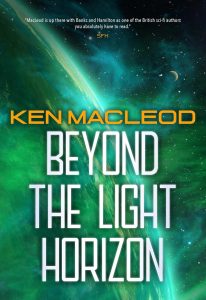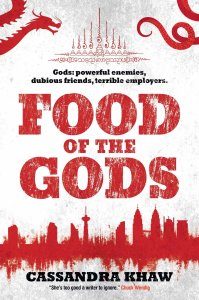Russell Letson Reviews Beyond the Light Horizon by Ken MacLeod
 Beyond the Light Horizon, Ken MacLeod (Orbit 978-0-356-51482-6, £10.99, 336 pp, tp) May 2024. Cover by Duncan Spilling. (Pyr 978-1-64506-066-6, $21.00, 336pp, tp) June 2024.
Beyond the Light Horizon, Ken MacLeod (Orbit 978-0-356-51482-6, £10.99, 336 pp, tp) May 2024. Cover by Duncan Spilling. (Pyr 978-1-64506-066-6, $21.00, 336pp, tp) June 2024.
Beyond the Light Horizon picks up right where Beyond the Reach of Earth (click to see review) ends, with Grant figuring out when he has landed and how he might return to his own time. But his problem is only the beginning of a considerable thematic and physical opening-out of the story space. As Lakshmi Nayak realized back in the first book, those FTL equations imply travel in time as well as space – but time, as it turns out, is not single-stranded, which complicates Grant’s problem considerably: Even if he gets back to 2071, will it be his 2071 or some variant?
In that home timestream, settlers from all three terrestrial power blocs have flocked to Apis to build new lives, though it becomes clear that the Fermi there do not welcome human occupancy, which inevitably encroaches on the native ecosystems and particularly on the monkey-spiders. And the monkey-spiders have another, Fermi-inspired ally. Marcus Owen has experienced changes in his internal cognitive systems thanks to a “fragment of [Fermi] presence lodged like shrapnel in his skull… tweaking the electronics of his own mind.” His mission is now to protect the monkey-spiders from human incursions. And that is not the only change he experiences.
While Alliance and Co-ord elbow each other on Apis and maintain garrisons on a scattering of habitable worlds where they’ve planted their virtual flags (and stashed nuclear weapons), the Station-turned-starship goes out surveying, finding “plenty of utterly uninhabitable systems, rich in resources but inimical to any kind of long-term habitation, even in habitats.” It is John Grant who, in his attempts to get back to his own time, hits the jackpot: a solar system filled with all manner of anomalous technological artifacts in orbit and three habitable worlds occupied by three civilized species – one standard human (the descendants of relocated Francophone Africans), one distantly and very anciently human-derived, and one dinosaurian. The latter two also have extremely long, complex histories that include interstellar travel programs, which are now suspended. And on the most nearly Earthlike “Planet 2” (later identified as “Terre Nouveau”), all three species live together in a comfortably layered multicultural society – particularly in the city of Saurienville – that somehow accommodates their quite distinct personalities.
After the Station locates him, the irrepressibly entrepreneurial Grant sees possibilities for trade with Terre Nouveau, finds a Union supply source and a local partner, and opens what sounds a lot like an Apple Store, selling Earth-style phones, networking gear, and VR glasses. (Actually, Grant would say, with excellent justification, that he is practicing economic democracy. But that’s a whole different set of conversations about the books’ political ideas.) When the Alliance and Co-ord turn from jostling for advantage on Apis and elsewhere and send armed parties to the Terre Nouveau system to do some bullying, they find that the three resident species are more than capable of making (and enforcing) their own arrangements and alliances – and, it turns out, of working within and around the diktats of the Fermi.
The disruptions that began with Black Horizon’s secret interstellar exploration and wound up with Grant’s phone emporium finally do settle into new sets of arrangements among and within the various human, near-human, and nonhuman factions and alliances, and a final, nonenigmatic communication from the Fermi clearly outlines their agenda and marks the boundaries of acceptable activity. Not that there won’t be attempts to get around them, somehow, by some, but the trilogy lands on a resolution that should hold for a while.
Many of the series’ underlying questions are those of humankind’s place among the infinities – about where we might go and why, how far is too far, and when is sufficiency enough. These are questions that science fiction has posed – or, sometimes, avoided examining too closely – forever, and experienced readers will catch echoes of voices ranging from Wells and Stapledon to Heinlein and Poul Anderson to Charles Stross and Iain M. Banks. Bringing us (and other thinking creatures) face-to-face with entities that are effectively godlike and not entirely clear and detailed in their communications makes us confront and consider some of those questions.
And a correction, two years late: In my review of Beyond the Hallowed Sky, I saw its future as set in an alternate history – a strategy that MacLeod has used in other work. Instead (as I was instructed first by the author and again by the backstory introduction to the second book), what we have is a secret history – a future with its roots hidden in our own present. The beginnings of the Lightspeed Trilogy are actually happening right now. Start watching the skies, readers.
Russell Letson, Contributing Editor, is a not-quite-retired freelance writer living in St. Cloud MN. He has been loitering around the SF world since childhood and been writing about it since his long-ago grad school days. In between, he published a good bit of business-technology and music journalism. He is still working on a book about Hawaiian slack key guitar.
This review and more like it in the June 2024 issue of Locus.
 While you are here, please take a moment to support Locus with a one-time or recurring donation. We rely on reader donations to keep the magazine and site going, and would like to keep the site paywall free, but WE NEED YOUR FINANCIAL SUPPORT to continue quality coverage of the science fiction and fantasy field.
While you are here, please take a moment to support Locus with a one-time or recurring donation. We rely on reader donations to keep the magazine and site going, and would like to keep the site paywall free, but WE NEED YOUR FINANCIAL SUPPORT to continue quality coverage of the science fiction and fantasy field.
©Locus Magazine. Copyrighted material may not be republished without permission of LSFF.








I should note that this is the second half of a review that covered volumes 2 and 3 of MacLeod’s Lightspeed Trilogy. It makes more sense when read after the first half, covering Beyond the Reach of Earth, posted here ten days ago and linked in the body of the review.